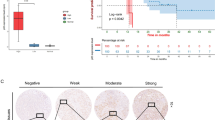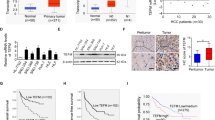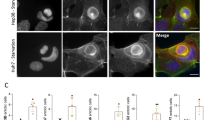Abstract
The presence of invasion into the extra-hepatic portion of the portal vein or the development of distant metastases renders hepatocellular carcinoma (HCC) patients ineligible for the only potential curative options for this malignancy—tumor resection or organ transplantation. Gene expression profiling of murine HCC cell lines identified KLF6 as a potential regulator of HCC cell migration. KLF6 knockdown increases cell migration, consistent with the correlation between decreased KLF6 mRNA levels and the presence of vascular invasion in human HCC. Concordantly, single-copy deletion of Klf6 in a HCC mouse model results in increased tumor formation, increased metastasis to the lungs and decreased survival, indicating that KLF6 suppresses both HCC development and metastasis. By combining gene expression profiling and chromatin immunoprecipitation coupled to deep sequencing, we identified novel transcriptional targets of KLF6 in HCC cells including VAV3, a known activator of the RAC1 small GTPase. Indeed, RAC1 activity is increased in KLF6-knockdown cells in a VAV3-dependent manner, and knockdown of either RAC1 or VAV3 impairs HCC cell migration. Together, our data demonstrate a novel function for KLF6 in constraining HCC dissemination through the regulation of a VAV3-RAC1 signaling axis.
This is a preview of subscription content, access via your institution
Access options
Subscribe to this journal
Receive 50 print issues and online access
$259.00 per year
only $5.18 per issue
Buy this article
- Purchase on Springer Link
- Instant access to full article PDF
Prices may be subject to local taxes which are calculated during checkout







Similar content being viewed by others
References
Ferlay J, Steliarova-Foucher E, Lortet-Tieulent J, Rosso S, Coebergh JW, Comber H et al. Cancer incidence and mortality patterns in Europe: estimates for 40 countries in 2012. Eur J Cancer 2013; 49: 1374–1403.
Hayat MJ, Howlader N, Reichman ME, Edwards BK . Cancer statistics, trends, and multiple primary cancer analyses from the Surveillance, Epidemiology, and End Results (SEER) Program. Oncologist 2007; 12: 20–37.
Katyal S, Oliver JH 3rd, Peterson MS, Ferris JV, Carr BS, Baron RL . Extrahepatic metastases of hepatocellular carcinoma. Radiology 2000; 216: 698–703.
Buendia MA . Genetics of hepatocellular carcinoma. Semin Cancer Biol 2000; 10: 185–200.
Villanueva A, Hoshida Y . Depicting the role of TP53 in hepatocellular carcinoma progression. J Hepatol 2011; 55: 724–725.
Lewis BC, Klimstra DS, Socci ND, Xu S, Koutcher JA, Varmus HE . The absence of p53 promotes metastasis in a novel somatic mouse model for hepatocellular carcinoma. Mol Cell Biol 2005; 25: 1228–1237.
Chen YW, Boyartchuk V, Lewis BC . Differential roles of insulin-like growth factor receptor- and insulin receptor-mediated signaling in the phenotypes of hepatocellular carcinoma cells. Neoplasia 2009; 11: 835–845.
Lee JS, Thorgeirsson SS . Genome-scale profiling of gene expression in hepatocellular carcinoma: classification, survival prediction, and identification of therapeutic targets. Gastroenterology 2004; 127: S51–S55.
Budhu A, Forgues M, Ye QH, Jia HL, He P, Zanetti KA et al. Prediction of venous metastases, recurrence, and prognosis in hepatocellular carcinoma based on a unique immune response signature of the liver microenvironment. Cancer Cell 2006; 10: 99–111.
Roessler S, Jia HL, Budhu A, Forgues M, Ye QH, Lee JS et al. A unique metastasis gene signature enables prediction of tumor relapse in early-stage hepatocellular carcinoma patients. Cancer Res 2010; 70: 10202–10212.
Kan Z, Zheng H, Liu X, Li S, Barber TD, Gong Z et al. Whole-genome sequencing identifies recurrent mutations in hepatocellular carcinoma. Genome Res 2013; 23: 1422–1433.
Fujimoto A, Totoki Y, Abe T, Boroevich KA, Hosoda F, Nguyen HH et al. Whole-genome sequencing of liver cancers identifies etiological influences on mutation patterns and recurrent mutations in chromatin regulators. Nat Genet 2012; 44: 760–764.
Kaposi-Novak P, Lee JS, Gomez-Quiroz L, Coulouarn C, Factor VM, Thorgeirsson SS . Met-regulated expression signature defines a subset of human hepatocellular carcinomas with poor prognosis and aggressive phenotype. J Clin Invest 2006; 116: 1582–1595.
Chen YW, Klimstra DS, Mongeau ME, Tatem JL, Boyartchuk V, Lewis BC . Loss of p53 and Ink4a/Arf cooperate in a cell autonomous fashion to induce metastasis of hepatocellular carcinoma cells. Cancer Res 2007; 67: 7589–7596.
Xue W, Krasnitz A, Lucito R, Sordella R, Vanaelst L, Cordon-Cardo C et al. DLC1 is a chromosome 8p tumor suppressor whose loss promotes hepatocellular carcinoma. Genes Dev 2008; 22: 1439–1444.
Zhou X, Zimonjic DB, Park SW, Yang XY, Durkin ME, Popescu NC . DLC1 suppresses distant dissemination of human hepatocellular carcinoma cells in nude mice through reduction of RhoA GTPase activity, actin cytoskeletal disruption and down-regulation of genes involved in metastasis. Int J Oncol 2008; 32: 1285–1291.
Lu X, Kang Y . Hypoxia and hypoxia-inducible factors: master regulators of metastasis. Clin Cancer Res 2010; 16: 5928–5935.
Thiery JP . Epithelial-mesenchymal transitions in tumour progression. Nat Rev Cancer 2002; 2: 442–454.
Kremer-Tal S, Narla G, Chen Y, Hod E, DiFeo A, Yea S et al. Downregulation of KLF6 is an early event in hepatocarcinogenesis, and stimulates proliferation while reducing differentiation. J Hepatol 2007; 46: 645–654.
Kremer-Tal S, Reeves HL, Narla G, Thung SN, Schwartz M, Difeo A et al. Frequent inactivation of the tumor suppressor Kruppel-like factor 6 (KLF6) in hepatocellular carcinoma. Hepatology 2004; 40: 1047–1052.
Tarocchi M, Hannivoort R, Hoshida Y, Lee UE, Vetter D, Narla G et al. Carcinogen-induced hepatic tumors in KLF6+/- mice recapitulate aggressive human hepatocellular carcinoma associated with p53 pathway deregulation. Hepatology 2011; 54: 522–531.
Gehrau RC, D'Astolfo DS, Dumur CI, Bocco JL, Koritschoner NP . Nuclear expression of KLF6 tumor suppressor factor is highly associated with overexpression of ERBB2 oncoprotein in ductal breast carcinomas. PLoS One 2010; 5: e8929.
Ito G, Uchiyama M, Kondo M, Mori S, Usami N, Maeda O et al. Kruppel-like factor 6 is frequently down-regulated and induces apoptosis in non-small cell lung cancer cells. Cancer Res 2004; 64: 3838–3843.
Narla G, Heath KE, Reeves HL, Li D, Giono LE, Kimmelman AC et al. KLF6, a candidate tumor suppressor gene mutated in prostate cancer. Science 2001; 294: 2563–2566.
Narla G, DiFeo A, Fernandez Y, Dhanasekaran S, Huang F, Sangodkar J et al. KLF6-SV1 overexpression accelerates human and mouse prostate cancer progression and metastasis. J Clin Invest 2008; 118: 2711–2721.
Hatami R, Sieuwerts AM, Izadmehr S, Yao Z, Qiao RF, Papa L et al. KLF6-SV1 drives breast cancer metastasis and is associated with poor survival. Sci Transl Med 2013; 5: 169ra112.
DiFeo A, Narla G, Camacho-Vanegas O, Nishio H, Rose SL, Buller RE et al. E-cadherin is a novel transcriptional target of the KLF6 tumor suppressor. Oncogene 2006; 25: 6026–6031.
Das A, Fernandez-Zapico ME, Cao S, Yao J, Fiorucci S, Hebbel RP et al. Disruption of an SP2/KLF6 repression complex by SHP is required for farnesoid X receptor-induced endothelial cell migration. J Biol Chem 2006; 281: 39105–39113.
Wurmbach E, Chen YB, Khitrov G, Zhang W, Roayaie S, Schwartz M et al. Genome-wide molecular profiles of HCV-induced dysplasia and hepatocellular carcinoma. Hepatology 2007; 45: 938–947.
Vetter D, Cohen-Naftaly M, Villanueva A, Lee YA, Kocabayoglu P, Hannivoort R et al. Enhanced hepatocarcinogenesis in mouse models and human hepatocellular carcinoma by coordinate KLF6 depletion and increased messenger RNA splicing. Hepatology 2012; 56: 1361–1370.
Leow CC, Wang BE, Ross J, Chan SM, Zha J, Carano RA et al. Prostate-specific Klf6 inactivation impairs anterior prostate branching morphogenesis through increased activation of the Shh pathway. J Biol Chem 2009; 284: 21057–21065.
Iizuka N, Oka M, Tamesa T, Hamamoto Y, Yamada-Okabe H . Imbalance in expression levels of insulin-like growth factor 2 and H19 transcripts linked to progression of hepatocellular carcinoma. Anticancer Res 2004; 24: 4085–4089.
Izumi R, Shimizu K, Kiriyama M, Hashimoto T, Urade M, Yagi M et al. Alpha-fetoprotein production by hepatocellular carcinoma is prognostic of poor patient survival. J Surg Oncol 1992; 49: 151–155.
Chen L, Chan TH, Yuan YF, Hu L, Huang J, Ma S et al. CHD1L promotes hepatocellular carcinoma progression and metastasis in mice and is associated with these processes in human patients. J Clin Invest 2010; 120: 1178–1191.
Ding J, Huang S, Wu S, Zhao Y, Liang L, Yan M et al. Gain of miR-151 on chromosome 8q24.3 facilitates tumour cell migration and spreading through downregulating RhoGDIA. Nat Cell Biol 2010; 12: 390–399.
Chen YW, Chu HC, Ze-Shiang L, Shiah WJ, Chou CP, Klimstra DS et al. p16 Stimulates CDC42-dependent migration of hepatocellular carcinoma cells. PLoS One 2013; 8: e69389.
Tan B, Li Y, Zhao Q, Fan L, Wang D, Liu Y . Inhibition of gastric cancer cell growth and invasion through siRNA-mediated knockdown of guanine nucleotide exchange factor Vav3. Tumour Biol 2014; 35: 1481–1488.
Lin KT, Gong J, Li CF, Jang TH, Chen WL, Chen HJ et al. Vav3-rac1 signaling regulates prostate cancer metastasis with elevated Vav3 expression correlating with prostate cancer progression and posttreatment recurrence. Cancer Res 2012; 72: 3000–3009.
Zeng L, Sachdev P, Yan L, Chan JL, Trenkle T, McClelland M et al. Vav3 mediates receptor protein tyrosine kinase signaling, regulates GTPase activity, modulates cell morphology, and induces cell transformation. Mol Cell Biol 2000; 20: 9212–9224.
Joberty G, Perlungher RR, Macara IG . The Borgs, a new family of Cdc42 and TC10 GTPase-interacting proteins. Mol Cell Biol 1999; 19: 6585–6597.
Hirsch DS, Pirone DM, Burbelo PD . A new family of Cdc42 effector proteins, CEPs, function in fibroblast and epithelial cell shape changes. J Biol Chem 2001; 276: 875–883.
Lyons LS, Burnstein KL . Vav3, a Rho GTPase guanine nucleotide exchange factor, increases during progression to androgen independence in prostate cancer cells and potentiates androgen receptor transcriptional activity. Mol Endocrinol 2006; 20: 1061–1072.
Narla G, Difeo A, Reeves HL, Schaid DJ, Hirshfeld J, Hod E et al. A germline DNA polymorphism enhances alternative splicing of the KLF6 tumor suppressor gene and is associated with increased prostate cancer risk. Cancer Res 2005; 65: 1213–1222.
Jonkers J, Meuwissen R, van der Gulden H, Peterse H, van der Valk M, Berns A . Synergistic tumor suppressor activity of BRCA2 and p53 in a conditional mouse model for breast cancer. Nat Genet 2001; 29: 418–425.
Postic C, Shiota M, Niswender KD, Jetton TL, Chen Y, Moates JM et al. Dual roles for glucokinase in glucose homeostasis as determined by liver and pancreatic beta cell-specific gene knock-outs using Cre recombinase. J Biol Chem 1999; 274: 305–315.
Lewis BC, Shim H, Li Q, Wu CS, Lee LA, Maity A et al. Identification of putative c-Myc-responsive genes: characterization of rcl, a novel growth-related gene. Mol Cell Biol 1997; 17: 4967–4978.
Gentleman RC, Carey VJ, Bates DM, Bolstad B, Dettling M, Dudoit S et al. Bioconductor: open software development for computational biology and bioinformatics. Genome Biol 2004; 5: R80.
Smyth GK . Linear models and empirical bayes methods for assessing differential expression in microarray experiments. Stat Appl Genet Mol Biol 2004; 3: Article 3.
Benjamini Y, Hochberg Y . Controlling the false discovery rate: a practical and powerful approach to multiple testing. J R Stat Soc Ser B (Methodological) 1995. 289–300.
Zheng Q, Wang XJ . GOEAST: a web-based software toolkit for Gene Ontology enrichment analysis. Nucleic Acids Res 2008; 36: W358–W363.
Zhang Y, Liu T, Meyer CA, Eeckhoute J, Johnson DS, Bernstein BE et al. Model-based analysis of ChIP-Seq (MACS). Genome Biol 2008; 9: R137.
Zhu LJ, Gazin C, Lawson ND, Pages H, Lin SM, Lapointe DS et al. ChIPpeakAnno: a Bioconductor package to annotate ChIP-seq and ChIP-chip data. BMC Bioinformatics 2010; 11: 237.
Acknowledgements
We thank Genentech for sharing Klf6flox mice; Scott Friedman for providing the Klf6flox mice and sharing data before publication. We thank JiuFeng Cai and Victor Adelanwa for technical assistance; Dr Kerry Burnstein for providing the VAV3 expression constructs; Karl Simin, Leslie Shaw, Scot Wolfe and members of the Lewis lab for helpful discussions and critical review of the manuscript. The assistance of the Memorial Sloan-Kettering Cancer Center Genomics Core and the University of Massachusetts Medical School Genomics and Deep Sequencing core facilities is gratefully acknowledged. This study was supported by NIH grant R01 CA121171 to BCL. The funders played no role in the design, execution or interpretation of the study.
Author information
Authors and Affiliations
Corresponding author
Ethics declarations
Competing interests
The authors declare no conflict of interest.
Additional information
Supplementary Information accompanies this paper on the Oncogene website
Supplementary information
Rights and permissions
About this article
Cite this article
Ahronian, L., Zhu, L., Chen, YW. et al. A novel KLF6-Rho GTPase axis regulates hepatocellular carcinoma cell migration and dissemination. Oncogene 35, 4653–4662 (2016). https://doi.org/10.1038/onc.2016.2
Received:
Revised:
Accepted:
Published:
Issue Date:
DOI: https://doi.org/10.1038/onc.2016.2
This article is cited by
-
SLC38A4 functions as a tumour suppressor in hepatocellular carcinoma through modulating Wnt/β-catenin/MYC/HMGCS2 axis
British Journal of Cancer (2021)
-
Hotspot mutant p53-R273H inhibits KLF6 expression to promote cell migration and tumor metastasis
Cell Death & Disease (2020)
-
Novel natural killer cell-mediated cancer immunotherapeutic activity of anisomycin against hepatocellular carcinoma cells
Scientific Reports (2018)
-
ATF3 reduces migration capacity by regulation of matrix metalloproteinases via NFκB and STAT3 inhibition in glioblastoma
Cell Death Discovery (2017)



